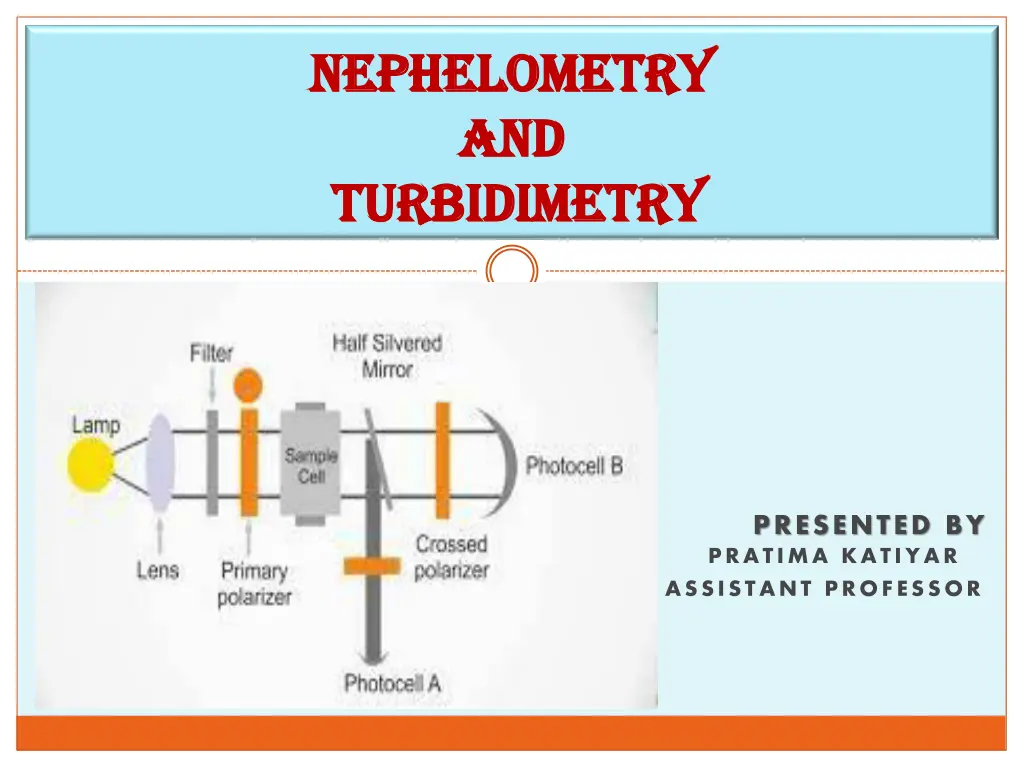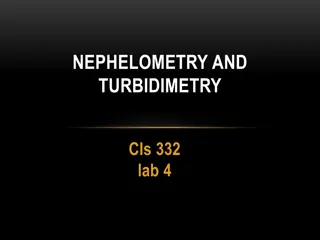
Understanding Nephelometry and Turbidimetry in Analytical Science
Explore the principles, methods, and applications of nephelometry and turbidimetry in analytical science, focusing on light scattering phenomena and measurement techniques. Learn about factors affecting the intensity of scattered light, instrumentation requirements, and practical uses in research and analysis.
Download Presentation

Please find below an Image/Link to download the presentation.
The content on the website is provided AS IS for your information and personal use only. It may not be sold, licensed, or shared on other websites without obtaining consent from the author. If you encounter any issues during the download, it is possible that the publisher has removed the file from their server.
You are allowed to download the files provided on this website for personal or commercial use, subject to the condition that they are used lawfully. All files are the property of their respective owners.
The content on the website is provided AS IS for your information and personal use only. It may not be sold, licensed, or shared on other websites without obtaining consent from the author.
E N D
Presentation Transcript
NEPHELOMETRY NEPHELOMETRY AND AND TURBIDIMETRY TURBIDIMETRY PRESENTED BY PRATIMA KATIYAR ASSISTANT PROFESSOR
CONTENT INTRODUCTION THEORY INSTRUMENTATION APPLICATION
INTRODUCTION When suspended particle in solution, some of the light will be absorbed by the particle, some will be transmitted through the solution and some of the light will be scattered or reflected. a electromagnetic radiation (light) strikes a The amount of light scattered is proportional to the concentration of insoluble particle in biphasic system . This will be focus on the concept of light scatter and measured the scattered light.
THEORY Scattered light may be measured by TURBIDIMETRY NEPHELOMETRY TURBIDIMETRY:- In turbidimetry, the intensity of light transmitted through the medium, the unscattered light, is measured.
Turbidometric measurement are made at 180 from the incident light beam.
NEPHELOMETRY In Nephelometry, the intensity of the scattered light is measured, usually, but not necessarily, at right angles to the incident light beam. The two techniques differ only in the manner of measuring the scattered radiation.
Turbidity can be measured on most routine analysers by a spectrophotometer (absorbed light) Reduced sensitivity and precision. Extent of light scattering increases as wavelength increases The intensity of scattered light is normally measured by Nephelometer.
Factors affecting Intensity of scattering light Light scattering is the physical phenomenon resulting from the interaction of light with a particles in solution. Dependent on: Particle size Wavelength Distance of observation Concentration of particles MW of particles
Instrumentation Radiation source Mainly used visible light sources e.g. tungsten lamp, Mercury lamp Monochromators Basically filters are used such as blue filter and visible filters. Sample cell: hexagonal made by glass, cylinderical in shape Detectors: photon detectors
Application 1. Analysis of inorganic substance impurity 2. Biochemical Analysis 3. food and beverage industry 4.Air and water pollution determination 5. Quantitative analysis. 6. determination of molecular weight of polymer 7. Phase titration
References Elementary organic Spectroscopy by Y. R. Sharma.



